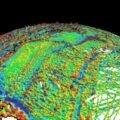Recent legislation approved by the House Intelligence Committee includes a mandate that would increase the sharing of data collected about unidentified aerial phenomena (UAP), according to language within the bill.
In a bipartisan voice vote that occurred on September 30, 2021, the United States House Permanent Select Committee on Intelligence approved its version of the Intelligence Authorization Act (IAA) for Fiscal Year 2022 (H.R. 5412). The bill includes language similar to that which appeared earlier this year in a version approved by the Senate Select Committee on Intelligence.
“Following a bipartisan oversight hearing on Unexplained Aerial Phenomena, the bill is carrying a bicameral provision mandating intelligence sharing with the Department of Defense’s UAP task force,” read a portion of a press statement at the Committee’s website under the heading “Persistent Pursuit of Unexplained Aerial Phenomena.”


“The provision will ensure that the task force will be able to fully draw on all classified reporting about UAPs as they continue to investigate this mysterious threat to U.S. airspace and our military forces,” the statement reads.
Notably, the appearance of UAP language in the bill represents the first time that the House Intelligence Committee has taken action directly addressing the issue of UAP. In 2020, a directive that originated with the Senate Intelligence panel resulted in both public and classified “preliminary assessments” on UAP, prepared by the Office of the Director of National Intelligence (ODNI) and the UAP Task Force, and delivered on June 25, 2021.
“Until now, there has never been explicit UFO/UAP language written into law,” says Douglas D. Johnson, a volunteer researcher with the Scientific Coalition for UAP Studies (SCU) who follows UAP-related developments in government as @ddeanjohnson on Twitter.
Johnson told The Debrief that “it is encouraging that three key congressional committees have now approved language to require the Executive Branch to ramp up and better coordinate UAP investigations, and to keep Congress better informed—and even more encouraging that the full House of Representatives has passed the more far-reaching of the proposals.”
In early August, The Debrief reported that the UAP Task Force would likely receive greater access to information collected by U.S. intelligence agencies related to UAP, based on provisions included by the Senate Select Committee on Intelligence within its version of the Intelligence Authorization Act for Fiscal Year 2022. The bill, which the Senate Select Committee on Intelligence passed in a bipartisan 16-0 vote that occurred in late July, detailed provision of funding and legal authority for a number of different components within the intelligence community.
It was subsequently reported by The Debrief that wording included in the FY 2022 National Defense Authorization Act (NDAA) (H.R. 4350), passed by the full U.S. House of Representatives on September 23, would call for the establishment of a permanent office to address unidentified aerial phenomena.
“Not later than 180 days after the date of the enactment of this Act, the Secretary of Defense, in coordination with the Director of National Intelligence, shall establish an office within the Office of the Secretary of Defense to carry out, on a Department-wide basis, the mission currently performed by the Unidentified Aerial Phenomenon Task Force as of the date of the enactment of this Act,” read a portion of the proposed legislation.
In addition, the House-passed NDAA spells out a number of specific “duties” for the new office, including “evaluating the threat that such incidents present to the United States” and “coordinating with allies and partners of the United States, as appropriate, to better assess the nature and extend of unidentified aerial phenomena.”


The House-passed bill would also require the new UAP office to submit classified reports to six congressional committees annually, which are to cover a list of ten items, including the number of UAP incidents “over restricted air space,” “an assessment of any health-related effects for individuals that have encountered [UAP],” and “an update on any efforts underway on the ability to capture or exploit discovered unidentified aerial phenomena.”
Johnson points out that the House-passed NDAA language is substantially broader and more specific than the provisions recommended by the House and Senate Intelligence committees. However, a version of the NDAA approved by the Senate Armed Services Committee currently contains no UAP language.
“It’s complicated,” Johnson told The Debrief. “There are four bill versions in play, and still many steps in the legislative process. There will be negotiation among the four key committees and opportunities for further improvements in the UAP provisions before they become law.”
One problem, Johnson said, is that neither the House-passed NDAA, nor the Intelligence committees’ proposals currently require the Executive Branch to produce any more unclassified, public reports on UAP-related findings, such as the Preliminary Assessment on Unidentified Aerial Phenomena released earlier this year.
Going forward, Johnson also emphasizes the importance of citizens appealing to their representatives about the issue of unexplained aerial phenomena, particularly those in states represented by members of Congress who serve on these committees.
“Voters who feel strongly that Congress should mandate periodic unclassified, public reports by the Executive Branch regarding UAP-related findings, should communicate their views to their respective senators and House members,” Johnson says, “especially if they serve on the armed services or intelligence committees.”
Follow and connect with author Micah Hanks on Twitter: @MicahHanks
Don’t forget to follow us on Twitter, Facebook, and Instagram, to weigh in and share your thoughts. You can also get all the latest news and exciting feature content from The Debrief on Flipboard, and Pinterest. And subscribe to The Debrief YouTube Channel to check out all of The Debrief’s exciting original shows: DEBRIEFED: Digging Deeper with Cristina Gomez –Rebelliously Curious with Chrissy Newton
